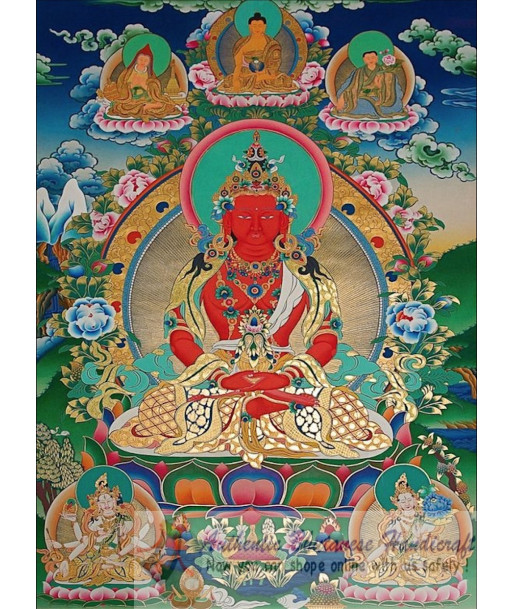- -50%






An **Amitayus Buddha (Sambhogakaya) Thanka** painting features Amitayus, a celestial form of Amitabha Buddha, emphasizing his aspect as the embodiment of longevity, health, and immortality. As a Sambhogakaya form, Amitayus represents one of the three bodies of a Buddha in the Vajrayana tradition, specifically the "Enjoyment Body," which manifests in a pure, celestial form for the benefit of advanced practitioners.
 Security policy
Security policy
(edit with the Customer Reassurance module)
 Delivery policy
Delivery policy
(edit with the Customer Reassurance module)
 Return policy
Return policy
(edit with the Customer Reassurance module)
An **Amitayus Buddha (Sambhogakaya) Thanka** painting features Amitayus, a celestial form of Amitabha Buddha, emphasizing his aspect as the embodiment of longevity, health, and immortality. As a Sambhogakaya form, Amitayus represents one of the three bodies of a Buddha in the Vajrayana tradition, specifically the "Enjoyment Body," which manifests in a pure, celestial form for the benefit of advanced practitioners.
### Key Elements of Amitayus Buddha (Sambhogakaya) Thanka Painting:
1. **Central Figure**:
- **Amitayus Buddha**: The central figure is Amitayus, depicted with the following attributes:
- **Appearance**: Amitayus is usually portrayed with a golden or red complexion, symbolizing his role in bestowing longevity and vitality. His serene and compassionate expression reflects his enlightened nature.
- **Posture**: He is often shown seated in a meditative posture or in the lotus position (Padmasana), symbolizing his peaceful and stable nature. Sometimes, he may be depicted sitting on a lotus flower or a throne.
2. **Attributes**:
- **Long-Life Vase**: Amitayus holds a long-life vase or *amrita* vase, which contains the nectar of immortality. This vase symbolizes his ability to grant extended life and protect against illness.
- **Mudras and Gestures**: His hand gestures (mudras) are often in positions that signify blessings and protection. He may be shown holding the vase with one hand or in a gesture of giving and receiving.
3. **Iconography**:
- **Lotus Flower**: Amitayus is commonly depicted seated on or surrounded by lotus flowers, representing purity, spiritual growth, and enlightenment.
- **Radiant Aura**: A halo or radiant light often encircles Amitayus, emphasizing his divine nature and the illumination he brings to practitioners.
4. **Background and Surroundings**:
- **Celestial or Sacred Landscape**: The background of the thanka may include heavenly realms, serene landscapes, or celestial gardens, enhancing the spiritual ambiance and reflecting the pure, blissful nature of the Sambhogakaya form.
- **Auspicious Symbols**: The painting might include additional auspicious symbols, such as the Eight Auspicious Signs (Ashtamangala), including the conch shell, wheel of Dharma, and parasol, which signify protection and blessings.
5. **Mantras and Texts**:
- **Inscriptions**: Tibetan script or mantras associated with Amitayus’s practice of longevity and health may be included around or within the painting. These texts are used in rituals and prayers to invoke Amitayus’s blessings for a long, healthy life.
### Significance:
- **Longevity and Immortality**: Amitayus is particularly venerated for his ability to bestow longevity and protect against illness. The thanka serves as a visual representation of his qualities, helping practitioners to focus on extending their lifespan and maintaining good health.
- **Sambhogakaya Aspect**: As a Sambhogakaya form, Amitayus represents the celestial body of a Buddha, providing teachings and blessings in a pure, enlightened form. This aspect is especially relevant for advanced practitioners seeking to connect with the higher realms of spiritual experience.
- **Spiritual Practice**: The Amitayus Thanka is used in meditation and rituals to connect with his blessings. Practitioners seek his guidance for both physical longevity and spiritual growth, incorporating his teachings into their practice.
The Amitayus Buddha (Sambhogakaya) Thanka painting is both a devotional object and a powerful tool for meditation, reflecting the profound and transformative qualities of Amitayus as the embodiment of longevity, health, and celestial wisdom in Tibetan Buddhism.